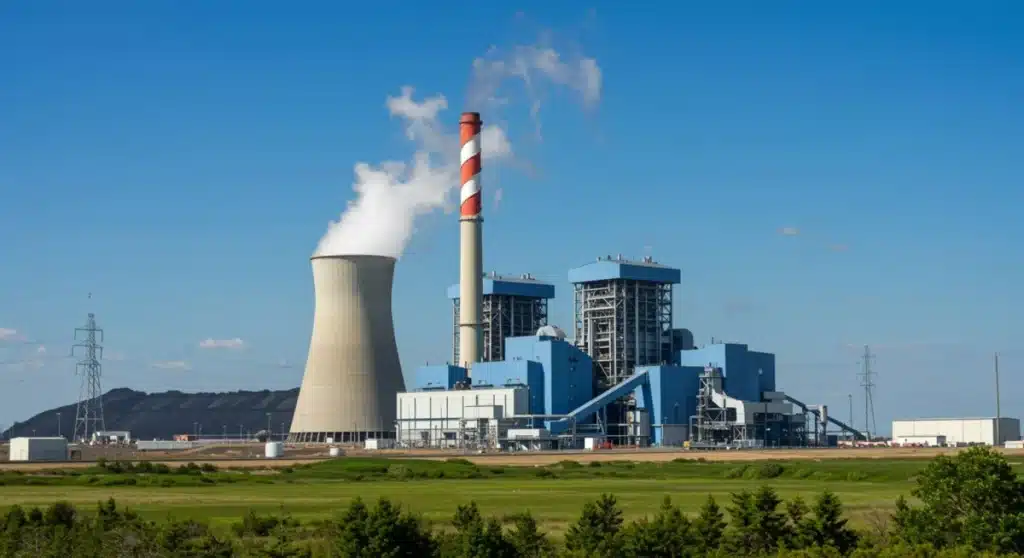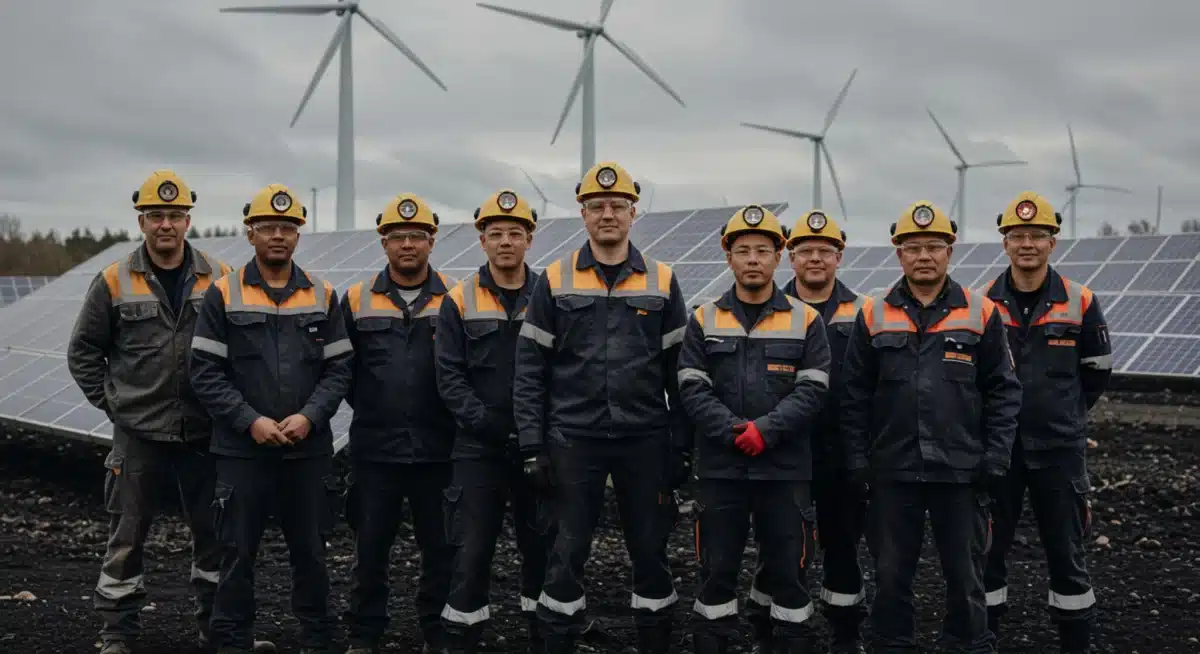Environmental Regulations’ Impact on US Coal Industry: A Deep Dive

New environmental regulations are significantly reshaping the US coal industry, driving a complex transition towards cleaner energy sources and challenging traditional economic models.
The landscape of energy production in the United States is undergoing a monumental transformation, with new environmental regulations playing a pivotal role. For decades, coal reigned as a primary energy source, fueling industries and homes across the nation. However, the increasing urgency of climate change and public health concerns has ushered in an era of stringent policies, fundamentally altering the trajectory of the coal industry environmental regulations are critical to comprehend for anyone observing the energy sector. This shift presents a complex web of economic, social, and technological challenges and opportunities that demand close examination.
The evolving regulatory framework: a historical perspective
Understanding the current state of the coal industry requires a look back at the historical evolution of environmental regulations. The journey from relatively lax oversight to today’s comprehensive policies has been incremental, often driven by landmark environmental disasters and growing scientific consensus regarding human impact on the planet.
Early environmental protections primarily focused on localized pollution, such as smog and contaminated water. However, as the scope of environmental science expanded, so too did the ambition of regulatory bodies. The Clean Air Act and Clean Water Act, foundational pieces of legislation, began to set precedents for emission standards and water discharge limits, directly affecting coal mining and power generation operations.
Key milestones in environmental legislation
Several legislative acts have significantly shaped the environmental compliance landscape for the coal industry. These policies introduced new technologies and operational changes, often at considerable cost.
- Clean Air Act (CAA): Initially passed in 1963 and significantly amended in 1970 and 1990, the CAA established national air quality standards and regulated emissions of hazardous air pollutants, including sulfur dioxide and nitrogen oxides, which are significant byproducts of coal combustion.
- Clean Water Act (CWA): Enacted in 1972, the CWA regulates pollutant discharges into U.S. waters, impacting wastewater treatment from coal mines and power plants.
- Resource Conservation and Recovery Act (RCRA): This 1976 law governs the disposal of solid and hazardous waste, including coal ash, a major byproduct of coal-fired power generation.
More recently, concerns about greenhouse gas emissions have led to further regulatory pressure. While direct federal legislation on carbon emissions specific to the coal industry has faced political hurdles, indirect regulations and international agreements have pushed for a reduction in fossil fuel reliance. The cumulative effect of these regulations has been a powerful force compelling the coal industry to adapt or face obsolescence.
In summary, the regulatory framework has steadily tightened over decades, moving from basic pollution control to a more holistic approach that addresses air, water, and waste, with an increasing focus on climate change. This evolution has created a challenging operational environment for coal-dependent businesses.
Economic repercussions and market shifts
The economic impact of environmental regulations on the coal industry is multifaceted, extending far beyond the direct costs of compliance. These policies have catalyzed significant market shifts, influencing investment patterns, employment figures, and the overall competitiveness of coal as an energy source.
Compliance with new regulations often necessitates substantial capital expenditure for coal companies. Installing advanced scrubbers to reduce sulfur dioxide emissions, upgrading wastewater treatment facilities, or investing in carbon capture technologies all come with hefty price tags. These costs can make older, less efficient coal plants economically unviable, leading to their early retirement.
Challenges to coal’s competitiveness
The rising cost of coal-fired electricity due to regulatory compliance has made it less competitive compared to increasingly affordable alternatives.
- Increased Operating Costs: Maintaining and operating pollution control equipment adds to the ongoing expenses of coal power plants.
- Investment Deterrence: Investors are increasingly shying away from coal projects due to regulatory uncertainty and the long-term risk associated with fossil fuels.
- Competition from Renewables: The dramatic drop in the cost of solar and wind power, coupled with government incentives, has made renewable energy a more attractive and often cheaper option for new power generation capacity.
This economic pressure has resulted in a noticeable decline in coal production and consumption in the U.S. Many coal mines have closed, and numerous coal-fired power plants have been decommissioned. This trend has significant implications for regions historically reliant on coal mining for employment and economic stability, leading to job losses and community displacement. The market is clearly signaling a preference for cleaner, more sustainable energy solutions, driven in part by regulatory mandates.

Technological innovations and adaptation strategies
In response to the tightening grip of environmental regulations, the coal industry has explored and, in some cases, adopted various technological innovations and adaptation strategies. While these efforts aim to mitigate the environmental footprint of coal, they also highlight the inherent challenges of making a historically polluting fuel source ‘cleaner.’
One significant area of development has been in emission control technologies. Flue gas desulfurization (FGD) systems, commonly known as scrubbers, have become standard equipment in many coal-fired power plants to remove sulfur dioxide. Similarly, selective catalytic reduction (SCR) systems are used to reduce nitrogen oxide emissions. These technologies, while effective, require considerable investment in both installation and ongoing maintenance.
Advancements in cleaner coal technologies
Beyond end-of-pipe solutions, research has focused on more fundamental changes to coal combustion.
- Carbon Capture, Utilization, and Storage (CCUS): This technology aims to capture carbon dioxide emissions from power plants and industrial facilities, preventing their release into the atmosphere. While promising, CCUS remains expensive and has faced challenges in widespread commercial deployment.
- Integrated Gasification Combined Cycle (IGCC): IGCC plants convert coal into a synthetic gas before combustion, allowing for easier removal of pollutants and potentially higher efficiency. However, IGCC plants are complex and costly to build.
- High-Efficiency, Low-Emissions (HELE) Technologies: These advanced coal-fired power plants operate at higher temperatures and pressures, leading to greater efficiency and reduced emissions per unit of electricity generated.
Despite these technological advancements, the fundamental challenge remains: coal, by its nature, is a carbon-intensive fuel. While innovations can reduce certain pollutants, completely eliminating carbon emissions from coal combustion is extraordinarily difficult and expensive. Many adaptation strategies also involve transitioning away from coal entirely, such as converting coal plants to run on natural gas or co-firing with biomass. The industry’s long-term viability increasingly hinges on its ability to embrace these transformative changes, or risk being outpaced by cleaner alternatives.
Impact on employment and regional economies
The transformation of the coal industry due to environmental regulations has had a profound and often painful impact on employment and regional economies, particularly in areas historically dependent on coal mining and power generation. The decline in coal demand has led to widespread job losses, creating significant social and economic challenges.
Coal mining communities, often isolated and with limited alternative industries, have borne the brunt of these changes. When mines close, not only do miners lose their jobs, but the ripple effect extends to local businesses that supported the industry, from equipment suppliers to restaurants. This economic contraction can lead to out-migration, declining tax bases, and a general sense of despair in affected towns.
Addressing the human cost of transition
Recognizing the human cost, various initiatives have emerged to support workers and communities through this transition.
- Retraining Programs: Efforts are underway to retrain coal workers for jobs in emerging industries, such as renewable energy, manufacturing, or technology. These programs aim to equip individuals with new skills relevant to the evolving job market.
- Economic Diversification: Governments and non-profits are working to attract new industries to coal-dependent regions, fostering economic diversification beyond fossil fuels. This can include investments in infrastructure, tourism, or small business development.
- Community Support: Providing social services, educational opportunities, and financial assistance to affected families and communities is crucial for managing the transition equitably.
The shift away from coal is not merely an environmental or economic issue; it is a profound social challenge that requires careful planning and compassionate policy. Ensuring a ‘just transition’ for coal workers and communities is paramount, mitigating the negative impacts while building new economic opportunities. This involves not just job creation, but also investing in the long-term resilience and sustainability of these regions. The future health of these communities depends on proactive measures to adapt to the new energy reality.

Policy debates and future outlook for coal
The future of coal in the United States remains a subject of intense policy debate, reflecting the complex interplay between environmental imperatives, economic realities, and political ideologies. While the trend towards cleaner energy is undeniable, the pace and specifics of coal’s decline are still contested.
Proponents of continued coal use often emphasize energy security, grid reliability, and the economic well-being of coal-producing regions. They argue that overly aggressive regulations can jeopardize these factors, leading to higher energy costs and job losses. On the other hand, environmental advocates and many scientists stress the urgent need to phase out coal to meet climate goals and protect public health. They point to the declining costs of renewables and the long-term benefits of a clean energy economy.
Key areas of ongoing policy discussion
Several critical policy areas continue to shape the outlook for coal.
- Carbon Pricing Mechanisms: Debates persist over implementing carbon taxes or cap-and-trade systems, which would directly increase the cost of carbon-intensive fuels like coal.
- Renewable Energy Incentives: The extent of federal and state incentives for solar, wind, and other renewable energy sources significantly influences their competitiveness against coal.
- Just Transition Policies: There’s increasing recognition of the need for policies that support coal communities and workers during the energy transition, including funding for retraining and economic diversification.
Looking ahead, the trajectory of the coal industry will likely be shaped by a combination of ongoing regulatory pressures, technological advancements in both coal and alternative energy, and the evolving political landscape. While a complete disappearance of coal from the energy mix in the near future is unlikely, its role is projected to continue to diminish. The emphasis is shifting towards retiring older, less efficient plants and exploring niche applications for coal where carbon capture technologies might make it viable. The long-term outlook suggests a significantly smaller, more specialized, and heavily regulated coal sector within a predominantly clean energy economy.
Global perspectives and international pressures
The impact of environmental regulations on the U.S. coal industry cannot be viewed in isolation. Global trends, international agreements, and the actions of other major economies significantly influence domestic policy and market dynamics. The worldwide push for decarbonization creates both pressure and opportunities for the U.S. to align its energy strategy with global climate goals.
Many nations, particularly in Europe, have already implemented aggressive policies to phase out coal, setting precedents and demonstrating the feasibility of transitioning to cleaner energy systems. International climate agreements, such as the Paris Agreement, although not directly dictating domestic energy mixes, create a framework of expectations and commitments that influence national policy decisions regarding fossil fuels.
Interconnectedness of global energy markets
The global nature of energy markets means that regulatory changes in one country can have ripple effects elsewhere.
- Export Markets: As domestic demand for U.S. coal declines, some companies have sought to increase exports. However, increasing global environmental regulations and competition from other coal-producing nations make this a challenging strategy.
- Technological Exchange: International collaboration in developing and deploying clean energy technologies, including carbon capture and renewable energy solutions, can accelerate the global energy transition.
- Climate Diplomacy: The U.S.’s stance on coal and climate policy influences its standing and effectiveness in international climate negotiations, impacting its ability to lead on global environmental issues.
The global energy transition is a complex, interconnected phenomenon. While the U.S. coal industry faces unique domestic challenges, it also operates within a broader international context where the momentum towards decarbonization is strong. This global pressure, combined with domestic regulatory and market forces, suggests a continued decline for coal, even as some countries may still rely on it for their energy needs. The long-term success of U.S. energy policy will, in part, be measured by its ability to navigate these global dynamics and contribute to a sustainable energy future.
| Key Impact Area | Brief Description of Impact |
|---|---|
| Economic Costs | Increased operational expenses and capital investment for compliance, leading to higher electricity costs and reduced competitiveness. |
| Market Shift | Decline in coal demand and production, accelerated by competition from cheaper renewable energy sources. |
| Technological Adaptation | Investment in emission control technologies (scrubbers, CCUS) and exploration of cleaner coal combustion methods. |
| Social & Employment | Job losses in coal regions, prompting calls for retraining programs and economic diversification efforts. |
Frequently asked questions about coal regulations
Key regulations include the Clean Air Act, which limits air pollutants like sulfur dioxide and nitrogen oxides, and the Clean Water Act, addressing water discharge. The Resource Conservation and Recovery Act also governs coal ash disposal, significantly increasing operational costs for coal companies.
Regulations have contributed to a substantial decline in both coal production and consumption. Increased compliance costs make coal less competitive against natural gas and renewables, leading to numerous mine closures and power plant retirements across the country.
Technologies like Carbon Capture, Utilization, and Storage (CCUS), Integrated Gasification Combined Cycle (IGCC), and High-Efficiency, Low-Emissions (HELE) plants aim to reduce coal’s environmental footprint. However, these solutions often face high costs and implementation challenges.
A ‘just transition’ refers to policies and programs designed to support coal workers and communities economically and socially as the nation shifts away from fossil fuels. This includes job retraining, economic diversification initiatives, and community support to mitigate negative impacts.
Global climate policies and international agreements, such as the Paris Agreement, exert pressure on the U.S. to reduce carbon emissions. This global momentum towards decarbonization reinforces domestic regulatory efforts and influences investment away from coal.
Conclusion
The analysis of the impact of new environmental regulations on the coal industry reveals a complex and ongoing transformation of the energy landscape in the United States. These regulations, evolving over decades, have fundamentally reshaped coal’s economic viability and operational practices. While posing significant challenges, particularly for employment in coal-dependent regions, they have also spurred technological innovation and accelerated the transition towards a cleaner, more sustainable energy future. The trajectory of the U.S. coal industry will continue to be influenced by a dynamic interplay of domestic policy, market forces, technological advancements, and global climate imperatives, underscoring the necessity of adaptive strategies and a commitment to a just transition for all affected communities.





